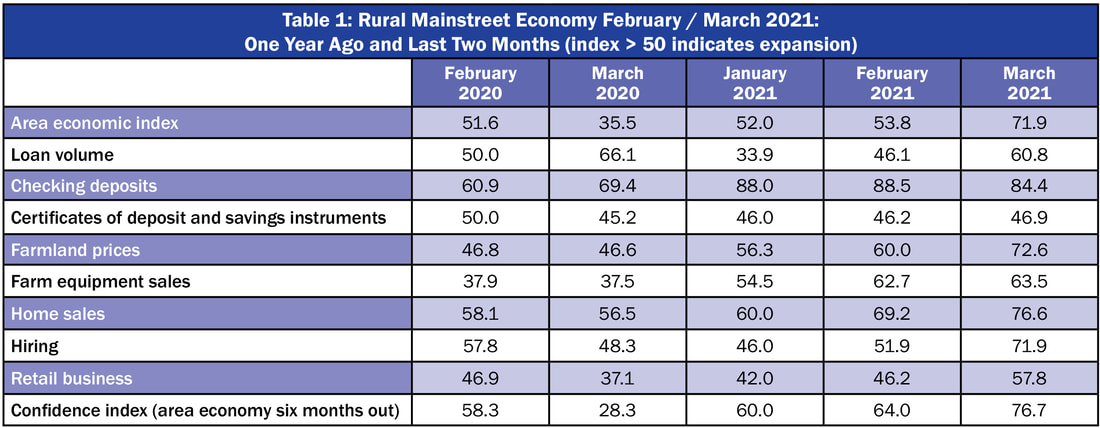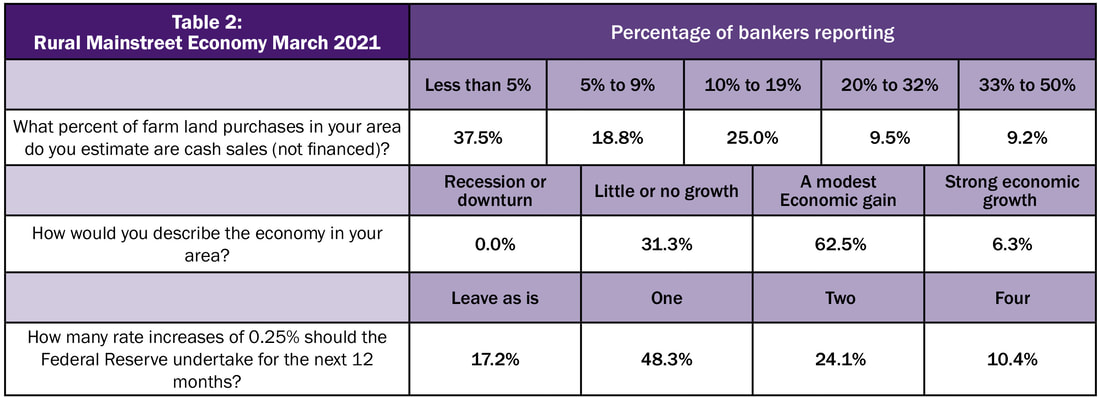- Overall index rocketed to a record high for the month.
- Approximately, 68.8% of bank CEOs reported an expanding local economy, while the remaining 31.2% indicated little or no growth.
- The farmland price index advanced its highest level since November 2012.
- The farm equipment-sales index rose to its highest reading since February 2013.
- Approximately 82.8% of bank CEOs recommended that the Federal Reserve raise interest rates by at least one-fourth of one percentage point in the next 12 months.
- Despite recent job gains, the region’s nonfarm employment level remains 218,600 jobs below its pre-COVID-19 level.
Overall: The overall index for March soared to a record high 71.9 from February’s solid 53.8. The index ranges between 0 and 100 with a reading of 50.0 representing growth neutral.
Approximately, 68.8% of bank CEOs reported that their local economy was expanding, while the remaining 31.2% indicated little or no growth.
“Sharp gains in grain prices, federal farm support, and the Federal Reserve’s record-low interest rates have underpinned the Rural Mainstreet Economy. Only 3.1% of bank CEOs indicated economic conditions worsened from the previous month. Even so, current rural economic activity remains below pre-pandemic levels,” said Ernie Goss, PhD, Jack A. MacAllister Chair in Regional Economics at Creighton University’s Heider College of Business.
Bankers reported that approximately 12.3% of farmland sales were cash sales, which is down from 17.3% recorded in February 2020.
The March farm equipment-sales index rose to 63.5, its highest reading since February 2013, and up from 62.7 in February. After 86 straight months of readings below growth neutral, farm equipment bounced into growth territory for the last four months.
Banking: For the first time since September of last year, bankers reported an expansion in loan volumes. The March loan volume index increased to 60.9 from February’s 46.1. The checking-deposit index sank from February’s record high 88.5 to 84.4, while the index for certificates of deposit, and other savings instruments, increased to 46.9 from 46.2 in February.
This month, 82.8% of bankers said they support at least one interest rate hike in the next 12 months.
Hiring: The new hiring index rocketed to 72.9 from 51.9 in February. Despite recent solid job gains for the region, data from the U.S. Bureau of Labor Statistics indicate that nonfarm employment levels for the Rural Mainstreet economy are down by 218,600 (nonseasonally adjusted), or 5.0%, compared to pre-COVID-19 levels.
“It will take many months of above growth neutral readings to get back to pre-COVID-19employment levels for the region,” said Goss.
Confidence: The confidence index, which reflects bank CEO expectations for the economy six months out, rose to a very healthy 76.7 and up from 64.0. “Looming federal farm support payments, improving gain prices, and advancing exports have supported confidence offsetting negatives from pandemic ravaged retail and leisure and hospitality companies in the rural economy,” said Goss.
Home and retail sales: The home-sales index climbed to 76.6 from 69.2 in February. The retail-sales index for March increased to healthy 57.8, highest reading since March 2013, from 46.2 in February. “Creighton’s survey will have to record many months above growth neutral retail numbers before it can be concluded that Rural Mainstreet retailers are truly rebounding,” said Goss.
This survey represents an early snapshot of the economy of rural agriculturally and energy-dependent portions of the nation. The Rural Mainstreet Index (RMI) is a unique index covering 10 regional states, focusing on approximately 200 rural communities with an average population of 1,300. It gives the most current real-time analysis of the rural economy. Goss and Bill McQuillan, former chairman of the Independent Community Banks of America, created the monthly economic survey in 2005 and launched in January 2006. Below are the state reports:
| Colorado: Colorado’s Rural Mainstreet Index (RMI) for March jumped to 70.0 from 35.6 in February. The farmland and ranchland-price index increased to 71.7 from February’s 50.9. Colorado’s hiring index for March soared to 72.0 from February’s 43.8. Compared to pre-COVID-19 levels, U.S. Bureau of Labor Statistics, non-seasonally adjusted data, indicate that Colorado’s Rural Mainstreet economy has lost 19,000 nonfarm jobs, or 5.6%, of its nonfarm employment. Illinois: The March RMI for Illinois advanced to 68.6 from 52.8 in February. The farmland-price index jumped to 71.0 from 59.4 in February. The state’s new-hiring index climbed to 71.3 from 52.3 in February. Compared to pre-COVID-19 levels, U.S. Bureau of Labor Statistics, non-seasonally adjusted data, indicate that Illinois’ Rural Mainstreet economy has lost 93,100 nonfarm jobs, or 7.0%, of its nonfarm employment. Iowa: The March RMI for Iowa bounced to 71.6 from February’s 54.0. Iowa’s farmland-price index rose to 72.4 from 60.1 in February. Iowa’s new-hiring index for March advanced to 72.7 from 53.0 in Iowa. Compared to pre-COVID-19 levels, U.S. Bureau of Labor Statistics, non-seasonally adjusted data, indicate that Iowa’s Rural Mainstreet economy has lost 25,800 nonfarm jobs, or 3.9%, of its nonfarm employment. Kansas: The Kansas RMI for March rocketed to 74.5 from 55.9 in February. The state’s farmland-price index increased to 73.9 from February’s 61.0. The new-hiring index for Kansas climbed to 74.2 from 53.9 in February. Compared to pre-COVID-19 levels, U.S. Bureau of Labor Statistics, non-seasonally adjusted data, indicate that Kansas’ Rural Mainstreet economy has lost 16,000 nonfarm jobs, or 3.8%, of its nonfarm employment. Minnesota: The March RMI for Minnesota soared to 69.2 from 48.5 in February. Minnesota’s farmland-price index climbed to 71.2 from 57.3 in February. The new-hiring index for March jumped to 71.5 from 50.2 in February. Compared to pre-COVID-19 levels, U.S. Bureau of Labor Statistics, non-seasonally adjusted data, indicate that Minnesota’s Rural Mainstreet economy has lost 26,700 nonfarm jobs, or 5.3%, of its nonfarm employment. Lonnie Clark, president of the State Bank of Chandler reported, “Higher grain prices will increase land prices and cash rent, but these long-term decisions are based on short term conditions that can change and undermine the cash flow.” | Missouri: The March RMI for Missouri climbed to 79.7 from February’s 66.2. The farmland-price index expanded to 76.5 from February’s 61.3. The state’s hiring gauge soared to 76,8 from 59.1 in February. Compared to pre-COVID-19 levels, U.S. Bureau of Labor Statistics, non-seasonally adjusted data, indicate that Missouri’s Rural Mainstreet economy has gained 200 nonfarm jobs, or 0.1%, of its nonfarm employment. Missouri is the only Rural Mainstreet state to have returned to pre-COVID-19 levels of non-farm employment. Nebraska: The Nebraska RMI for March soared o 78.8 from February’s 58.4. The state’s farmland-price index climbed to 76.1 from last month’s 62.3. Nebraska’s new-hiring index advanced to 78.4 from 55.2 in February. Compared to pre-COVID-19levels, U.S. Bureau of Labor Statistics, non-seasonally adjusted data, indicate that Nebraska’s Rural Mainstreet economy has lost 3,400 nonfarm jobs, or 1.2%, of its nonfarm employment. Jim Stanosheck, CEO of State Bank of Odell in Odell reported, “A farm sale last week of 700 acres saw dry land farm sell between $3,750 and $5,575 an acre. North Dakota: The North Dakota RMI for March increased to 57.0 from February’s 41.2. The state’s farmland-price index expanded to 65.2 from 53.7 in February. The state’s new-hiring index expanded to 65.5 from February’s 40.3. Compared to pre-COVID-19 levels, U.S. Bureau of Labor Statistics, non-seasonally adjusted data, indicate that North Dakota’s Rural Mainstreet economy has lost 18,300 nonfarm jobs, or 11.3% (largest share in the region), of its nonfarm employment. South Dakota: The March RMI for South Dakota advanced to 76.6 from February’s 59.6. The state’s farmland-price index climbed to 74.9 from 62.9 in February. South Dakota’s March hiring index rose to 75.2 from 55.8 in February. Compared to pre-COVID-19 levels, U.S. Bureau of Labor Statistics, non-seasonally adjusted data, indicate that South Dakota’s Rural Mainstreet economy has lost 5,600 nonfarm jobs, or 2.7%, of its nonfarm employment. Wyoming: The March RMI for Wyoming soared to 81.9 from February’s 54.9. The March farmland and ranchland-price index expanded to 77.6 from 60.5 in February. Wyoming’s new-hiring index rocketed to 77.9 from February’s 53.4. Compared to pre-COVID-19levels, U.S. Bureau of Labor Statistics, non-seasonally adjusted data, indicate that Wyoming’s Rural Mainstreet economy has lost 10,900 nonfarm jobs, or 5.6%, of its nonfarm employment. |



 RSS Feed
RSS Feed